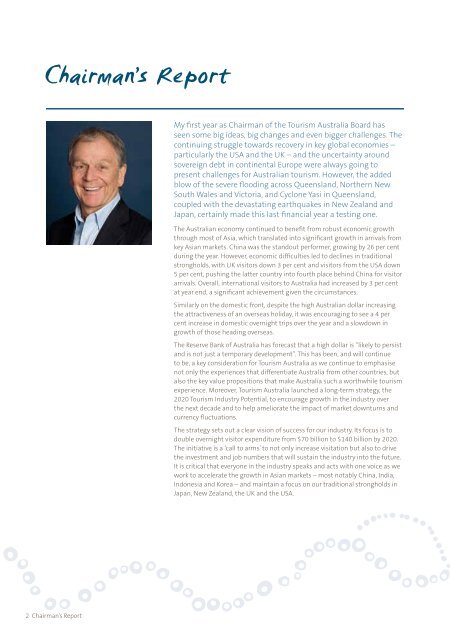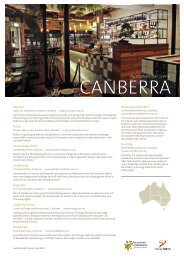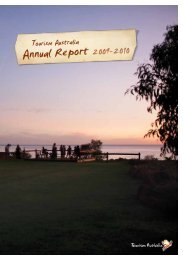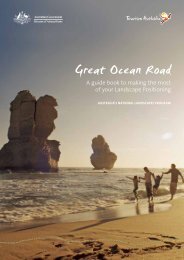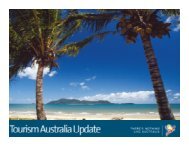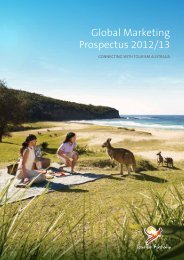Annual Report 2010-2011 - Tourism Australia
Annual Report 2010-2011 - Tourism Australia
Annual Report 2010-2011 - Tourism Australia
You also want an ePaper? Increase the reach of your titles
YUMPU automatically turns print PDFs into web optimized ePapers that Google loves.
Chairman’s <strong>Report</strong><br />
My first year as Chairman of the <strong>Tourism</strong> <strong>Australia</strong> Board has<br />
seen some big ideas, big changes and even bigger challenges. The<br />
continuing struggle towards recovery in key global economies –<br />
particularly the USA and the UK – and the uncertainty around<br />
sovereign debt in continental Europe were always going to<br />
present challenges for <strong>Australia</strong>n tourism. However, the added<br />
blow of the severe flooding across Queensland, Northern New<br />
South Wales and Victoria, and Cyclone Yasi in Queensland,<br />
coupled with the devastating earthquakes in New Zealand and<br />
Japan, certainly made this last financial year a testing one.<br />
The <strong>Australia</strong>n economy continued to benefit from robust economic growth<br />
through most of Asia, which translated into significant growth in arrivals from<br />
key Asian markets. China was the standout performer, growing by 26 per cent<br />
during the year. However, economic difficulties led to declines in traditional<br />
strongholds, with UK visitors down 3 per cent and visitors from the USA down<br />
5 per cent, pushing the latter country into fourth place behind China for visitor<br />
arrivals. Overall, international visitors to <strong>Australia</strong> had increased by 3 per cent<br />
at year end, a significant achievement given the circumstances.<br />
Similarly on the domestic front, despite the high <strong>Australia</strong>n dollar increasing<br />
the attractiveness of an overseas holiday, it was encouraging to see a 4 per<br />
cent increase in domestic overnight trips over the year and a slowdown in<br />
growth of those heading overseas.<br />
The Reserve Bank of <strong>Australia</strong> has forecast that a high dollar is “likely to persist<br />
and is not just a temporary development”. This has been, and will continue<br />
to be, a key consideration for <strong>Tourism</strong> <strong>Australia</strong> as we continue to emphasise<br />
not only the experiences that differentiate <strong>Australia</strong> from other countries, but<br />
also the key value propositions that make <strong>Australia</strong> such a worthwhile tourism<br />
experience. Moreover, <strong>Tourism</strong> <strong>Australia</strong> launched a long-term strategy, the<br />
2020 <strong>Tourism</strong> Industry Potential, to encourage growth in the industry over<br />
the next decade and to help ameliorate the impact of market downturns and<br />
currency fluctuations.<br />
The strategy sets out a clear vision of success for our industry. Its focus is to<br />
double overnight visitor expenditure from $70 billion to $140 billion by 2020.<br />
The initiative is a ‘call to arms’ to not only increase visitation but also to drive<br />
the investment and job numbers that will sustain the industry into the future.<br />
It is critical that everyone in the industry speaks and acts with one voice as we<br />
work to accelerate the growth in Asian markets – most notably China, India,<br />
Indonesia and Korea – and maintain a focus on our traditional strongholds in<br />
Japan, New Zealand, the UK and the USA.<br />
2 Chairman’s <strong>Report</strong>


